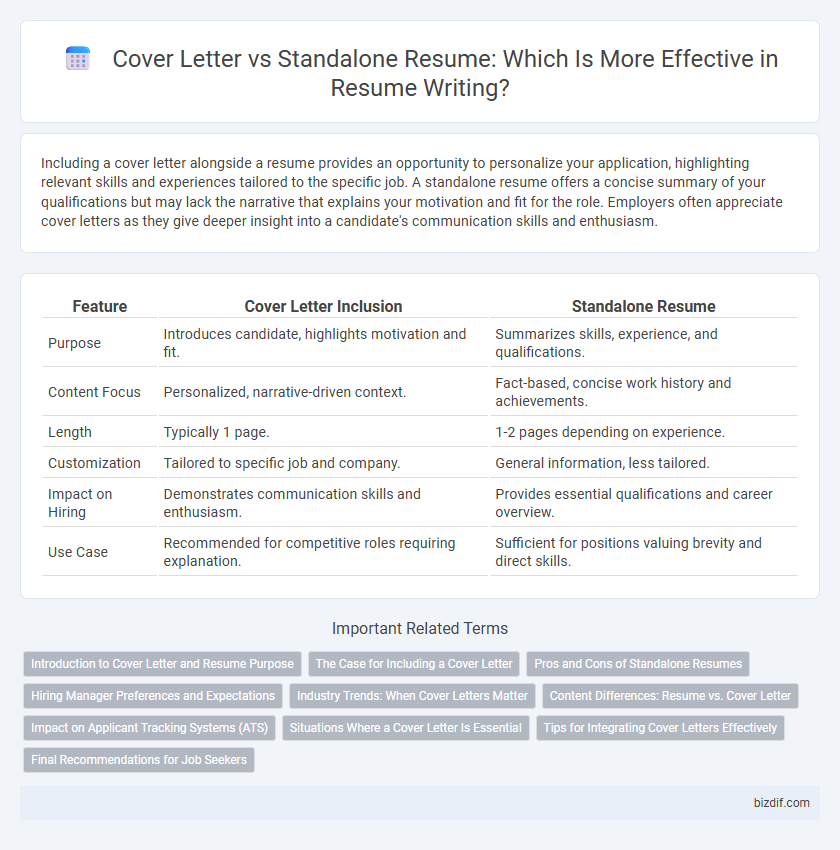Including a cover letter alongside a resume provides an opportunity to personalize your application, highlighting relevant skills and experiences tailored to the specific job. A standalone resume offers a concise summary of your qualifications but may lack the narrative that explains your motivation and fit for the role. Employers often appreciate cover letters as they give deeper insight into a candidate's communication skills and enthusiasm.
Table of Comparison
| Feature | Cover Letter Inclusion | Standalone Resume |
|---|---|---|
| Purpose | Introduces candidate, highlights motivation and fit. | Summarizes skills, experience, and qualifications. |
| Content Focus | Personalized, narrative-driven context. | Fact-based, concise work history and achievements. |
| Length | Typically 1 page. | 1-2 pages depending on experience. |
| Customization | Tailored to specific job and company. | General information, less tailored. |
| Impact on Hiring | Demonstrates communication skills and enthusiasm. | Provides essential qualifications and career overview. |
| Use Case | Recommended for competitive roles requiring explanation. | Sufficient for positions valuing brevity and direct skills. |
Introduction to Cover Letter and Resume Purpose
A well-crafted cover letter serves as a personalized introduction that highlights key qualifications and aligns them with the job requirements, demonstrating enthusiasm and professionalism. The resume provides a detailed, structured overview of work experience, skills, and accomplishments, acting as the core document for employment evaluation. Including a cover letter alongside the resume increases the chances of capturing the hiring manager's attention and effectively communicates the candidate's motivation.
The Case for Including a Cover Letter
Including a cover letter in your job application significantly enhances your resume by providing personalized context and showcasing your communication skills to potential employers. Cover letters allow candidates to highlight specific accomplishments and explain how their experience aligns with the job requirements, differentiating them from other applicants. Studies show that hiring managers are 34% more likely to consider candidates who submit tailored cover letters alongside their resumes.
Pros and Cons of Standalone Resumes
Standalone resumes offer a concise summary of skills and experience, allowing recruiters to quickly assess qualifications without extra context. They eliminate the need for tailoring content for each application, saving time but potentially missing personalized connection with employers. However, standalone resumes may lack the narrative depth and motivation insight that a cover letter provides, limiting the presentation of soft skills and enthusiasm.
Hiring Manager Preferences and Expectations
Hiring managers often prefer receiving a cover letter alongside a standalone resume, as the cover letter provides insight into the candidate's personality, motivation, and specific interest in the role. While resumes summarize qualifications and experience concisely, cover letters offer context and demonstrate communication skills, increasing the likelihood of progressing in the hiring process. Incorporating a tailored cover letter aligns with employer expectations, enhancing the overall application impact.
Industry Trends: When Cover Letters Matter
Cover letter inclusion remains a vital component in industries such as finance, law, and academia, where personalized communication highlights candidate suitability beyond resume bullet points. Employers in creative fields and startups often value cover letters for showcasing cultural fit and storytelling abilities alongside resumes. Recent trends reveal that while tech giants may prioritize concise standalone resumes for automation compatibility, specialized roles still demand tailored cover letters to demonstrate candidate intent and motivation.
Content Differences: Resume vs. Cover Letter
A resume concisely highlights professional experience, skills, and accomplishments, focusing on quantifiable achievements and job-specific keywords to pass applicant tracking systems. A cover letter offers a personalized narrative that explains career motivations, aligns skills with the company's needs, and demonstrates cultural fit through storytelling and targeted examples. While resumes emphasize structured data and brevity, cover letters provide context, personality, and a persuasive argument for candidacy.
Impact on Applicant Tracking Systems (ATS)
Including a cover letter alongside a standalone resume increases the chances of passing Applicant Tracking Systems (ATS) by providing additional keyword opportunities and context about the applicant's skills. ATS software scans both documents to evaluate relevant qualifications, and a well-crafted cover letter can highlight specific achievements that align with job descriptions. Omitting a cover letter may limit keyword presence, reducing the likelihood of the resume advancing through automated filters.
Situations Where a Cover Letter Is Essential
Including a cover letter is essential when applying for roles that require personalized communication or when the job listing explicitly requests it, as it provides an opportunity to highlight relevant skills and motivations. Employers in competitive fields such as marketing, education, and corporate management often expect cover letters to assess candidates' written communication abilities and cultural fit. In situations involving career changes or gaps, a cover letter effectively explains context that a standalone resume cannot.
Tips for Integrating Cover Letters Effectively
Incorporate key achievements and personalized details from your cover letter into the resume summary to create a cohesive narrative highlighting your unique qualifications. Use consistent formatting and language tone between the cover letter and resume to reinforce professionalism and brand identity. Tailor both documents to the specific job description, emphasizing skills and experiences most relevant to the employer's needs.
Final Recommendations for Job Seekers
Job seekers should include a tailored cover letter alongside their resume to provide context and highlight relevant skills that align with the job description. A standalone resume may suffice for initial screenings, but a well-crafted cover letter increases the chances of capturing employer attention by addressing specific role requirements and demonstrating genuine interest. Prioritizing both documents ensures a comprehensive application that maximizes interview opportunities.
Cover Letter Inclusion vs Standalone Resume Infographic

 bizdif.com
bizdif.com